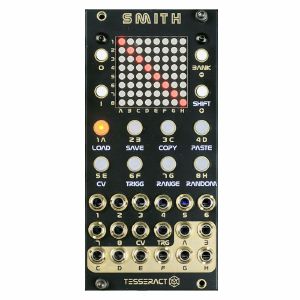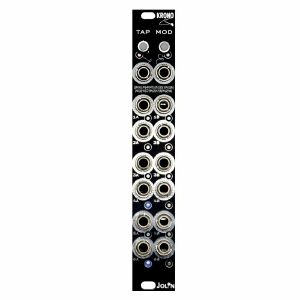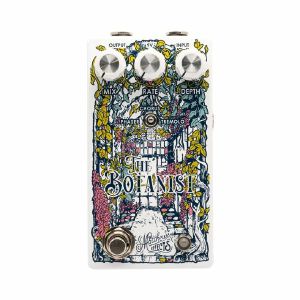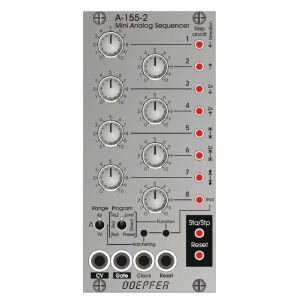Coming soon: All genres
All genres vinyl due out soonThis is not a mixer, the same input can be routed to many outputs, but several inputs can't be present at the same output simultaneously. The module works with both audio and CV signals, ins & outs have i10 volts range and minimum offset (1 millivolt approx.), which makes it perfect for distributing V/Oct signals too.
8 scenes that can be accessed through the dedicated push buttons but also by CV and trigger. 8 banks (with 8 scenes each, 64 scenes per preset). 8 persistent presets (with 8 banks of 8 scenes each).
This module can be used to store 'presets' for your live setup, allowing patch changes and easy rerouting signals with literally just pressing a button.
Another (more chaotic) way to use it is to plug several modulation sources to the inputs (such as envelopes, LFOs, sequenced CVs) and several modulation destinations to the outputs (filter cutoff, PWM, VCAs...). If you want to introduce a variation in the sound, select a different scene or directly randomize the current one to drastically change 'what is modulating what'.
Using audio sources can lead us to interesting territories too, sequencing waveform changes or using different processors (filter, distortion, folder...). Keep in mind that the switch performs pretty fast and the signal is passed without any modification (to preserve its accuracy, which is pretty important when using the module for v/oct) so with audio, the switching may be clicky. This depends on the sound source too, with 'dirty' ones there's no problem but with clean ones, like low pitched sine waves, it will be.
This product is available for pre-order at Juno, for shipping on the release date. You won’t be charged until the order is despatched.
We'll keep you informed of your order at every stage, and let you know if the release date changes.
If the price of the item drops before it's released, you will pay the lower price, but if it increases, you'll only pay the price you see today.
If you also include in-stock items on your order, they’ll be charged and shipped within 24 hours as usual.All 12 outputs are customizable, and everything runs on an STM32F411 - with open code available via GitHub for advanced users and developers.
Modes - firmware v1.0
Ratios: Direct multiplications and divisions of the base tempo for proportional rhythmic ratios.
Euclidean: Generates Euclidean rhythms by distributing K pulses over N steps.
Musical: Applies common musical ratios (e.g., triplets, dotted notes, predefined swing divisions).
Probabilistic: Outputs trigger based on defined probability thresholds for each output.
Sequential: Generates clocks based on mathematical sequences (Fibonacci, prime numbers).
Swing: Applies individual swing/shuffle levels per output, delaying even beats.
Polyrhythm: Assigns independent X:Y ratios to outputs; output 6 can generate a logical sum.
Logic: Applies logic operations (AND, OR, XOR, NAND, XNOR) between internal clocks or external inputs (if configured).
Phasing: Generates pulses with configurable time offsets (phase shifts) relative to the main clock.
Chaos: Creates unpredictable rhythmic patterns based on chaotic algorithms
This product is available for pre-order at Juno, for shipping on the release date. You won’t be charged until the order is despatched.
We'll keep you informed of your order at every stage, and let you know if the release date changes.
If the price of the item drops before it's released, you will pay the lower price, but if it increases, you'll only pay the price you see today.
If you also include in-stock items on your order, they’ll be charged and shipped within 24 hours as usual.When function Direct (Direction) is selected these running modes are available:
Up
Down
2 x Up (each step is played twice with the normal tempo, not to be confused with Ratcheting x2, see below)
2 x Down (each step is played twice with the normal tempo, not to be confused with Ratcheting x2, see below)
Pendulum type 1 (start and end step are played twice)
2 x Pendulum type 1 (each step is played twice with the normal tempo, start and end step are played 4x)
Pendulum type 2 (start and end step are played once)
Random (Rnd)
When function Preset is selected the illuminated buttons are used to call up one of the 8 presets. In each preset these parameters are stored: active steps, running direction, length of the sequence, ratcheting. To call up one of the 8 stored presets one has to push and hold the button Function and then operate short-time one of the buttons 1 - 8 while the toggle switch Program is in position Preset. To store the present paramaters in one of the 8 presets the procedure is similar but one has to operate one of the buttons 1 - 8 for a longer time (approx 3 seconds).
Depending on the position of the Program toggle switch the Ratcheting button is used to program the ratcheting feature (x2, x3, x4) individually for each step of the sequence (toggle switch Program in position Rx2, Rx3 or Rx4). In case that at the step in question another ratcheting is already programmed (eg x2 or x3 when x4 is chosen) the other ratcheting is overwritten (kind of radio button function between the ratchetings x2, x3 and x4). Details about the ratcheting function are explained at the module A-160-5.
The button Start/Stop is used to start or stop the sequence manually. Button Reset sets the sequence to the first step. For this also the external input Reset can be used.
The module does not feature built in clock generator. Rather an external Clock signal is used. The positive edge of the incoming clock signal triggers the advance of the sequence to the next step.
The voltage range of the control voltage generated by the module can be switched to 3 different ranges by the toggle switch Range: 0 - +1V / 0 - +2V / 0 - +4V. The control voltage is available at socket CV. The voltage is not quantized. But there is an internal pin header available that outputs the data via Midi (note on/off from Midi note 36. Midi channel 1). It can be used to control a MIDI-to-CV interface if quantized control voltages are required, eg the planned Micro-CV-Interface A-190-9)
The Gate signal appears at socket Gate. The pulsewidth of the gate signal is defined by the pulsewidth of the clock signal provided that ratcheting is not active at the step in question.
Controls and displays:
1 - 8 (rotary controls): manual adjustment of the control voltage for each step
1 - 8 (illuminated momentary switches/buttons): manual gate setting for each step, also used for special functions in combination with other controls (setting of first/last step, running direction, ratcheting)
Range: toggle switch for selection of the control voltage range
Program: toggle switch for selection of a function in combination with the buttons Ratcheting and Function
Ratcheting: button for the programming of ratcheting in combination with the toggle switch Program
Function: button for the programming of sequence length (Limit) and running direction (Direct) as well as for the Preset management (Preset)
Sta/Stp: button for the manual control of Start and Stop, in running state the LED of this button displays the state of the Gate output (ie it flashes in the rhythm of the Gate output)
Reset : manual reset button
CV : control voltage output
Gate : gate output
Clock: clock input, the pulsewidth of the clocjk signal defines the pulsewidth gate signal
Reset: reset control input, reset type selectable via internal jumpers (eg positive edge triggers the jump to first step/positive leveltriggers the jump to first step and remains at first step as long as the reset input is high/waiting for the next positive edge of the clock signals before reset is carried out)
This product is available for pre-order at Juno, for shipping on the release date. You won’t be charged until the order is despatched.
We'll keep you informed of your order at every stage, and let you know if the release date changes.
If the price of the item drops before it's released, you will pay the lower price, but if it increases, you'll only pay the price you see today.
If you also include in-stock items on your order, they’ll be charged and shipped within 24 hours as usual.Easily tailor your sound using the three intuitive knobs: Mix, Rate, and Depth. Employ the Mix knob to smoothly blend your wet signal, fine-tune the Rate knob to govern the effect's tempo, and adjust the Depth knob to modulate the effect's intensity to your liking.
"The Botanist" is equipped with MIDI capabilities, granting you remote control over bypass, presets, algorithms, and features. Engage the 'Hold' function by holding down the "Bypass/Hold" switch, which instantly maxes out the Depth control and seamlessly restores it to its previous setting upon release.
With six presets at your fingertips, "The Botanist" simplifies switching between your preferred sounds, and its compact design ensures it's the ideal companion for gigging musicians. Whether you find yourself in an intimate club or a sprawling stadium, count on "The Botanist" to consistently deliver your ideal tone.
For musicians seeking a compact, versatile, and top-tier effect, "The Botanist" stands as the quintessential guitar pedal. Featuring three distinct algorithms, MIDI functionality, a convenient Hold function, and an array of six preset slots, "The Botanist" becomes your ultimate musical companion, opening doors to uncharted sonic horizons.
Highlights
The futurist can send any kind of MIDI message allowing you control of anything that has MIDI!
16 messages per preset
Send a total of 16 MIDI messages per preset on any MIDI channel!
Plenty of presets!
The Futurist has 210 total presets organized into 30 banks of 7 !
Programable footswitches
Program each footswitch to be a preset, tap, bank up, bank down, preset up, and preset down. Customize your Futurist to meet your needs!
MIDI Clock
The Futurist can generate its own MIDI clock or pass along MIDI clock from an outside source!
Message triggers
The Futurist supports Press, Release, Long Press, Long Release, Toggle On and Toggle Off as message triggers
Unique features
Midi communication over USB, manage presets and update firmware (with Matthews Effects Editor), and power The Futurist.
3.5MM TRS MIDI IN/OUT
connect directly to devices that use a TRS connection for MIDI and can be used with adapters to connect to 14 inch MIDI connections.
5-pin MIDI IN
Connect to devices that use the traditional 5 pin midi connector.
Utility jack
Configurable to send analogue tap tempo signals or as a latching or momentary switch.
Control jack
Plug in an expression pedal to dynamically send Control Change messages over MIDI or configure the jack to accept 3 additional switches to expand the functionality of the futurist.
Technical
High-grade components selected for their superior quality
3.5mm, traditional 5 pin and USB MIDI connections
Utility jack lets you send analogue tap or switch signals
Control jack lets you use expression or add 3 additional switches
Foot-switches designed to last against the abuse of the road
9V 50MA
Computer Editor
The Matthews Effects Editor allows you to manage presets, update firmware and improve the control ability of your Matthews Effects products from the ease of your Mac or PC!
This product is available for pre-order at Juno, for shipping on the release date. You won’t be charged until the order is despatched.
We'll keep you informed of your order at every stage, and let you know if the release date changes.
If the price of the item drops before it's released, you will pay the lower price, but if it increases, you'll only pay the price you see today.
If you also include in-stock items on your order, they’ll be charged and shipped within 24 hours as usual.Rapid WILL+ delivers groundbreaking 20ms latency- 20x faster than conventional Bluetooth - enabling real-time audio that moves at the speed of creativity. Mix, scratch, cue: zero lag, pure sync, so your hands and ears stay perfectly aligned.
Limited to 200 units, each with a hand-signed postcard.
This product is available for pre-order at Juno, for shipping on the release date. You won’t be charged until the order is despatched.
We'll keep you informed of your order at every stage, and let you know if the release date changes.
If the price of the item drops before it's released, you will pay the lower price, but if it increases, you'll only pay the price you see today.
If you also include in-stock items on your order, they’ll be charged and shipped within 24 hours as usual.coming soon $160.56
When function Direct (Direction) is selected these running modes are available:
Up
Down
2 x Up (each step is played twice with the normal tempo, not to be confused with Ratcheting x2, see below)
2 x Down (each step is played twice with the normal tempo, not to be confused with Ratcheting x2, see below)
Pendulum type 1 (start and end step are played twice)
2 x Pendulum type 1 (each step is played twice with the normal tempo, start and end step are played 4x)
Pendulum type 2 (start and end step are played once)
Random (Rnd)
When function Preset is selected the illuminated buttons are used to call up one of the 8 presets. In each preset these parameters are stored: active steps, running direction, length of the sequence, ratcheting. To call up one of the 8 stored presets one has to push and hold the button Function and then operate short-time one of the buttons 1 - 8 while the toggle switch Program is in position Preset. To store the present paramaters in one of the 8 presets the procedure is similar but one has to operate one of the buttons 1 - 8 for a longer time (approx 3 seconds).
Depending on the position of the Program toggle switch the Ratcheting button is used to program the ratcheting feature (x2, x3, x4) individually for each step of the sequence (toggle switch Program in position Rx2, Rx3 or Rx4). In case that at the step in question another ratcheting is already programmed (eg x2 or x3 when x4 is chosen) the other ratcheting is overwritten (kind of radio button function between the ratchetings x2, x3 and x4). Details about the ratcheting function are explained at the module A-160-5.
The button Start/Stop is used to start or stop the sequence manually. Button Reset sets the sequence to the first step. For this also the external input Reset can be used.
The module does not feature built in clock generator. Rather an external Clock signal is used. The positive edge of the incoming clock signal triggers the advance of the sequence to the next step.
The voltage range of the control voltage generated by the module can be switched to 3 different ranges by the toggle switch Range: 0 - +1V / 0 - +2V / 0 - +4V. The control voltage is available at socket CV. The voltage is not quantized. But there is an internal pin header available that outputs the data via Midi (note on/off from Midi note 36. Midi channel 1). It can be used to control a MIDI-to-CV interface if quantized control voltages are required, eg the planned Micro-CV-Interface A-190-9)
The Gate signal appears at socket Gate. The pulsewidth of the gate signal is defined by the pulsewidth of the clock signal provided that ratcheting is not active at the step in question.
Controls and displays:
1 - 8 (rotary controls): manual adjustment of the control voltage for each step
1 - 8 (illuminated momentary switches/buttons): manual gate setting for each step, also used for special functions in combination with other controls (setting of first/last step, running direction, ratcheting)
Range: toggle switch for selection of the control voltage range
Program: toggle switch for selection of a function in combination with the buttons Ratcheting and Function
Ratcheting: button for the programming of ratcheting in combination with the toggle switch Program
Function: button for the programming of sequence length (Limit) and running direction (Direct) as well as for the Preset management (Preset)
Sta/Stp: button for the manual control of Start and Stop, in running state the LED of this button displays the state of the Gate output (ie it flashes in the rhythm of the Gate output)
Reset : manual reset button
CV : control voltage output
Gate : gate output
Clock: clock input, the pulsewidth of the clocjk signal defines the pulsewidth gate signal
Reset: reset control input, reset type selectable via internal jumpers (eg positive edge triggers the jump to first step/positive leveltriggers the jump to first step and remains at first step as long as the reset input is high/waiting for the next positive edge of the clock signals before reset is carried out)
This product is available for pre-order at Juno, for shipping on the release date. You won’t be charged until the order is despatched.
We'll keep you informed of your order at every stage, and let you know if the release date changes.
If the price of the item drops before it's released, you will pay the lower price, but if it increases, you'll only pay the price you see today.
If you also include in-stock items on your order, they’ll be charged and shipped within 24 hours as usual.
 USD
USD










